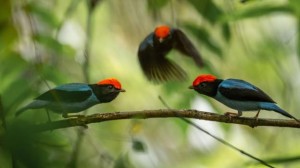Week 49 – 18 June 2017:
Profound Discoveries About Little-Known Birds
The grand diversity of life ensures that no bird enthusiast could ever become bored with the group. With more than ten thousand species occupying endless niches in countless habitat types, ornithologists always have something new to investigate. This wealth of research opportunities was emphasized by the March 2017 issue of the scholarly publication The Wilson Journal of Ornithology. Featuring 15 major articles and 14 short communications, the first six papers described birds that I had never heard of.
Forests of Central and South America continue to hold many surprises for bird biologists. In 1986, a new antbird, the Rondonia Bushbird, was discovered in an Amazonian forest in southern Brazil. Almost all aspects of the biology of this antbird remained undescribed until Thiago Costa of the Universidade de São Paulo in Brazil and coworkers started to fill in the gaps. Previously known from just a single female specimen, the male’s plumage was described in detail for the first time. Grey and black, it is, admittedly, kind of dull when compared to the rust-and-black female. These birds occupies dense unflooded forests, and may be able to tolerate a degree of habitat alteration by humans. Given that they are antbirds, it is not surprising that Rondonia Bushbirds were found to eat mainly ants.
There are seven recognized subspecies of the Tawny-throated Leaftosser, distributed widely across Central and South America. Many researchers believe that the species should be subdivided. Jacob Cooper and Andés Cuervo of Louisiana State University in the United States studied variation in the vocalizations of this leaftosser across its range. They found five distinctive song groups, and these corresponded to differences in other observable characteristics. According to Cooper et al., we should recognize five species in place of one, with the names Tawny-throated Leaftosser, Isthmian Leaftosser, Dusky Leaftosser, Andean Leaftosser and Guianan Leaftosser. Time will tell if the remainder of the ornithological community agrees with them.
The Hawaiian Crow, also known as the ‘Alalā, persists only as two captive populations; one at the Keauhou Bird Conservation Center on Hawai’i Island, and one at the Maui Bird Conservation Center on Maui. The goal is to breed them in captivity, and release the offspring in order to reestablish wild populations. Ann Tanimoto of the University of Hawai’i and her coworkers studied the vocal repertoire of captive ‘Alalā. They hoped that their data would serve to indicate the range of vocalizations in wild populations in the past, and allow future researchers to follow changes in those vocalizations in future wild populations. “These comparisons can provide a better understanding of the way environmental factors influence social learning in oscine birds,” observed Tanimoto et al.
Fruithunters are elusive thrushes, found only in montane habitat on the island of Borneo. As with so many tropical birds, their breeding biology has been poorly documented. Over a seven year period, Adam Mitchell of the University of Montana and his coworkers made observations of forty-two Fruithunter nests. Most nests contained two eggs, weighing a little over six grams each. Only females incubated the eggs and brooded chicks in the nest, but both parents fed nestlings. Chicks fledged after approximately 18 days. For thrushes of their size, Fruithunters had small clutches and long periods before fledging. Mitchell et al. speculated that this slow rate of breeding might allow for a longer lifespan for adults.
Despite being abundant and having a wide distribution in South America, the breeding biology of the Wren-like Rushbird has been poorly studied. Nicolás Chiaradia and his coworkers at the Universidad Nacional de Mar del Plata in Argentina considered these birds in the wetlands of Buenos Aires province. Life seems pretty tough for breeding Wren-like Rushbirds. Forty-three percent of the nests they discovered were abandoned during the nest-building stage. A further 38% were preyed upon, and 5% were destroyed. Only 14% of nesting attempts successfully fledged chicks. Late in the season, when the wetlands dried up, almost all active nests failed.
Blue Manakins living in the understory of forests in southwestern Brazil seem to have a slightly better time of it. The sexual displays of these tiny fruit-eating birds has been reasonably well studied, but their breeding biology has received a lot less attention. Paulo Zima and his coworkers at the Universidad Federal de São Carlos in Brazil studied Blue Manakins at thirty-six nests over two breeding seasons. Their shallow cup nests were built over water, and all contained two eggs. Young nestlings has dark grey downy feathers over dark red skin. The chicks were fed by the female parent only, and this may be related to their frugivorous diet; acquiring enough fruit to feed the chicks may not be very demanding, allowing for male desertion. Overall, 34% of nests successfully fledged chicks.
For many species of birds, our understanding of their lives is quite limited. Future generations of ornithologists will still find endless questions awaiting answers.
Photo credits: Tawny-throated Leaftosser © Joao Quental, Macaulay Library ML36928781 – macaulay.org; Blue Manakins – 985thejewel.com/video-long-line-of-suitors-for-female-blue-manakin/



